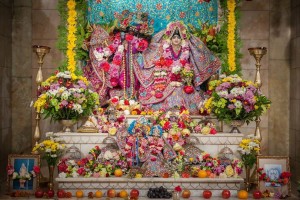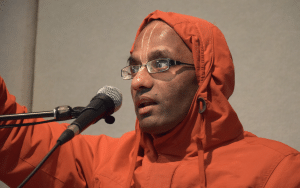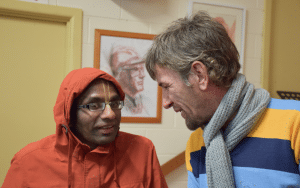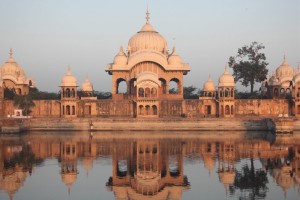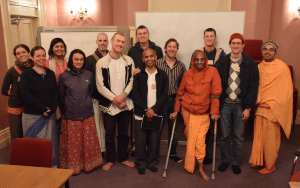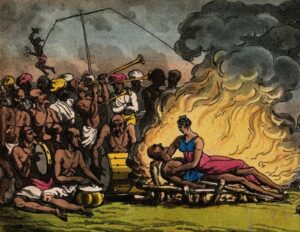Some eight years ago my spiritual master His Holiness Radhanath Swami Maharaj told me to learn to write for a Western audience. He explained that since Indians were also getting westernized, material written for a Western audience would appeal to them too.
Since then, I have read various books written by devotee-authors for a Western audience. Then I corresponded by email with many of these devotee-authors, appreciating their works and offering to serve them as an editor for their future books. During the ensuing interactions, I got to know the story behind the story – how they came to write what they wrote. Based on the guidance of these devotees, I read many books written for a Western audience by other spiritual authors – Christians, yoga teachers, Buddhists, academic scholars of religion and post-modern thinkers – paying special attention to their choice of diction, style and content.
Finally after nearly a decade of distant preparation and at the prompting of several devotee-authors, I recognized that I needed to interact with my audience firsthand to understand them better. Accordingly, when Muralidhar Prabhu, who has long appreciated my talks and writings, and has even arranged the translation of three of my books into Chinese, invited me to come to Melbourne, I accepted the invitation.
After taking the blessings of senior devotees and offering my prayers to Their Lordships Sri Sri Radha Gopinath – “Let this trip deepen my conviction that you, O Lord, are the only ultimate substance and that everything else, no matter how attractive-looking, is eventually insubstantial” – I embarked on the tour to Melbourne from 27th May to 9th June, 2015.
A heartwarming blend of the natural and the devotional
The eighteen-hour flight with a five-hour jet lag was uneventfully pleasant. I landed at Melbourne in the early morning cold in what was the coldest part of the year on one of the southernmost parts of Australia. As we drove to the temple, I noticed that the architecture of Melbourne was a pleasing blend of the traditional and the modern. In the Melbourne ISKCON temple, the central building is the oldest building in the whole area and is a heritage building. It also contains a large devotional heritage room: The room in which Srila Prabhupada lived during his visit in 1975 has been preserved as it is.
With comforting greenery in the premises, the temple atmosphere is a heartwarming blend of the natural and the devotional. The Deities are the divinely beautiful Radha Vallabha, Jagannatha-Baldeva-Subhadra and Gaur-Nitai. By their sacred presence, they manifest in Melbourne simultaneously the three holiest abodes of Gaudiya Vaishnavism: Vrindavan, Jagannath Puri and Mayapur.
I had three illuminating meetings with the Temple President, His Grace Aniruddha Prabhu, who has been a rock of stability for the Melbourne community for the last twenty-five years. He explained the temple’s outreach strategy centered on prasad distribution. When Srila Prabhupada had come there, he had said that anyone from around ten miles should be able to come to the temple and get free prasad. Accordingly, the temple has been providing free prasad – and opulent prasad with multiple items at that – three times a day to all visitors for several decades. Additionally, through its two restaurants, the temple reaches to a significant number of Australians and creates by this gustatory outreach the human connections foundational for philosophical outreach. An ongoing kitchen expansion project will expand the outreach substantially – with the expanded kitchen, the temple will be able to start several more restaurants. The center also has a vibrant educational ethos with several Bhakti-Shastri, Bhakti-Vaibhava and Bhakti-Vedanta courses being conducted.
Cricket Metaphors
My first talk was on 28th evening at Mantra Lounge, which is a youth center close to Melbourne University. Entitled “Love is in the SOUND”, the talk attracted students from various countries. But I had to pay the price for spin-doctoring my topic. For me, SOUND was an acronym (Satisfying, Omnipotent, Universal, Non-material, Direct) that conveyed the qualities of the sound of the maha-mantra, which manifests the infinite’s love for the finite. But for the students, the topic fuelled a set of romantic and sentimental expectations that my talk obviously couldn’t fulfill. Though they heard me politely, they asked no questions and later conveyed their disappointment to the local youth coordinator who thereafter gave me candid feedback.
For most Indians – and I am no exception – the mention of Australia usually brings thoughts of cricket; India’s cricket rivalry with Australia is intense, second only to its rivalry with Pakistan. So the thought of cricket was lurking at the back of my mind right from the start of my Australian visit. As I contemplated the feedback, a cricket metaphor sprang up, leaving me shaking my head ruefully. My “international debut” had been underwhelming – though I hadn’t been dismissed for a duck, still I had run myself out before reaching double figures even. Thankfully, I had many more innings to redeem myself.
My next class was on the evening of Pandava Nirjala Ekadashi. Speaking on the Bhagavad-gita to a friendly audience of devotees was like playing on home turf. Based on the Gita 5.17, I spoke on “Overcoming obstacles at the levels of the mind, intelligence and faith” and answered several thoughtful questions.
The next class was the temple Bhagavatam class on 30th morning on a technical section of the third canto dealing with creation. I spoke on “Conceptual, conversational and chronological background of the Bhagavatam’s creation narrative” and could see a few impressed and many dazed faces in the audience. After the class, as I contemplated the future classes which would be more technical than this one, another cricket metaphor popped up in my mind and had me laughing. If I went on into the technicalities of the Bhagavatam’s division of species, I felt I would be like a batsman raising his bat to hit a sixer and finding that there was no ball, no baller, no umpire, no fielders, no spectators – just the batsman swinging the bat through the empty air on an empty ground. Few if any in the audience would be able to connect with the technicalities. I intended no disrespect to my audience’s intelligence; just that a technical analysis would require charts and powerpoints – and couldn’t be done in a Bhagavatam class. A special seminar for interested devotees doing a Bhakti Vaibhava course would be a more appropriate forum.
As I considered alternative strategies for dealing with the subject, I found myself pondering the universal human questions that the Bhagavatam’s technical presentation sought to answer. And as I contemplated the answers for those questions provided by other, more contemporary knowledge-sources, I found a way to present the topic intelligibly. During my subsequent Bhagavatam classes, I compared the scientific, Christian and Bhagavatam conceptions of the nature and purpose of creation, the possibility of extra-terrestrial life, the difference between humans and animals and the nature of time. After the classes, many devotees asked intelligent, well-informed questions, thereby demonstrating that they could connect with the analysis. I felt that this topic could well become the theme for a book (another addition to the many book dreams that I don’t know whether I will be able to actualize in this life).
A stirring spiritual experience
My second class to a Western audience was at the Urban Yoga Center on the topic of “The Anxiety Epidemic.” I spoke how overemphasis on personality (how we appear) at the expense of the person (who we actually are) is a major cause of anxiety. It was after the class that I had the most moving experience of my entire Australian visit. While I was giving the class, I was too caught in doing things – trying to present the bhakti message in the most intelligible way. But when the soothing kirtan started, the wonder of it all struck me: seeing the Western faces all around me drove home the point that I was really in a far-away country, in Australia, to be precise. Seeing an African-Australian Mataji leading the kirtan, several Australian Matajis playing the instruments and seeing various Australian faces blissfully singing the holy names drove home the universality of bhakti. Geographically, culturally, intellectually, there may be much that separates us, but bhakti-yoga unites us all by enabling us to experience the common core of our being – the heart that longs to love and be loved, the heart that finds its ultimate fulfillment in loving God and singing his glories.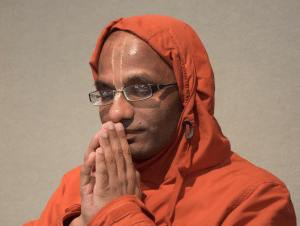 I felt as if the whole scene was surreal, a flashback to the times when Srila Prabhupada began it all single-handedly in a small storefront inLower East Side, New York. Here, all I had to do was just give a talk while a whole team did everything else. But Srila Prabhupada had to do it all himself. How incredibly difficult it must have been for him! I had spoken and written on Srila Prabhupada’s unbreakable, inconceivable determination, but contemplating it on the mission field of Australia took my appreciation and gratitude to a much higher level. The fact that many sincere people were taking to bhakti-yoga here down under was a spiritual wonder – a living miracle that had manifested as the fruition of the careful passing on of the bhakti legacy by generations of saintly teachers.
I felt as if the whole scene was surreal, a flashback to the times when Srila Prabhupada began it all single-handedly in a small storefront inLower East Side, New York. Here, all I had to do was just give a talk while a whole team did everything else. But Srila Prabhupada had to do it all himself. How incredibly difficult it must have been for him! I had spoken and written on Srila Prabhupada’s unbreakable, inconceivable determination, but contemplating it on the mission field of Australia took my appreciation and gratitude to a much higher level. The fact that many sincere people were taking to bhakti-yoga here down under was a spiritual wonder – a living miracle that had manifested as the fruition of the careful passing on of the bhakti legacy by generations of saintly teachers.
Sattvika Courtship
In between my many classes (I gave some 16 classes and 2 QA sessions), I met many devotees. On one of the days, the Temple Vice-President, Nanda Mandir Prabhu, told me that his spiritual master and one of the GBCs (Governing Body Commissioners) there, His Holiness Devamrita Maharaja, had a whole system for courting: If a devotee-couple desired to marry, they were asked to first go through a period of two-year courting with all meetings during the first year supervised by a chaperone. The system struck me as remarkably sattvika and just suited for curbing the rajas inherent in romance.
When I met Devamrita Maharaja later and appreciated the courtship system, he told me how it had been hugely successful in bringing stability and longevity to marriages among Western devotee couples. We had an absorbing discussion for one-and-half hours on various styles of writing and speaking for Western audiences. Maharaja also connected me with his team that is producing the captivatingly contemporary ENOUGH magazine to attract Westerners to Krishna.
Later, I contemplated further on the courtship system. I had written a few years ago that to resist our impulses, we all need to develop our own pause buttons – some customized set of actions that counter the pressure of our impulses and restore our capacity to think clearly. It struck me that this courtship system is an excellent example of a socially arranged pause button.
These thoughts were churning through my mind when I spoke one evening at a youth meeting on the topic, “Emotion Commotion Devotion: Nourishing our emotions in a culture of emotional exploitation” While addressing the question, “Which are better: love marriages or arranged marriages?” I pointed out that the nomenclature itself was biased – it implied that arranged marriages had no love in them, and that those who favored arranged marriages were against love. Someone biased the other way could well rephrase the question as: “Which are better: infatuation marriages or arranged marriages?” The point is that the foundation for a sustainable marriage cannot be the infatuation of “Love at first sight”; it has to be the commitment that enables one to continue loving after many sights. For millions of people for millennia, that commitment came from having their marriages arranged and blessed by elders.
In contrast, rajo-guna with its infatuation rivets our vision to our emotion, letting us see only those things that agree with the present emotion. Initially, rajo-guna makes one feel, “I can’t live without you.” But when inevitable differences and disagreements crop up, the same rajo-guna makes one feel, “I can’t live with you.” The pause button of the waiting period allows time for sattva-guna to return and broaden the uni-dimensional vision of rajo-guna. With this expanded vision, one can make a more mature decision about the relationship.
As the cultural values in India change and devotee-couples increasingly choose love marriages (I use this term for lack of a non-judgmental alternative), I feel that sociological improvisations such as a sattvika courting system will be needed in India – sooner rather than later.
Appreciation-without-infatuation
In our spiritual evolution, we all go through phases. Like most Indians, I had grown up with a deep-rooted Western infatuation. After I started practicing bhakti-yoga in my youth, I oscillated, like many other young Indian devotees, towards the opposite, indulging in blanket condemnation of the West. Whenever I look back at some of the articles about Western culture I wrote ten years ago, I periodically catch myself wincing at the sweeping generalizations.
Probably I needed nearly two decades of devotional purification and spiritual maturation to come to the balanced state of appreciation-without-infatuation and criticism-without-condemnation. During my visit to Australia, I could see much to appreciate. Meticulous organization of things was evident everywhere – from the arrangement for half-flush in washrooms to conserve water to the symmetrical positioning and systematic numbering of houses on both sides of the roads to the provision of ramps at all public places for people with special needs. I could only wish that if India could organize things even half as well, so many people – Indians included – could be saved from the negative first impression that prevents them from looking deeper for India’s spiritual wisdom. Indeed, many have been the Western minds who though fascinated by reading Indian wisdom-literature were dismayed on actually coming to India, bemoaning, “How could people so organized in their philosophical thinking be so disorganized in their practical living?”
The impressive material organization in Australia notwithstanding, I could discern signs of a pervasive inner emptiness. As Australian psychological and sociological surveys testify, emotions are often in chaos and relationships are frequently in a mess. When in my talks I quoted sociologists who reported the paradoxical finding, “People in the developing world have far more to be worried about than people in the developed world, yet people in the developed world are more worried than people in the developing world,” I could see many Western heads nodding. And when I quoted how immigrants from the developing world to the developed world tend to have higher stress levels after immigration, I could see many Indian heads nodding too.
Moving moments with devotees
By far the most encouraging aspect of the visit for me was getting to know the many devotees who were actively using the content from thespiritualscientist.com and gitadaily.com. Being able to replace the statistics of site visitors with the faces of intelligent devotees was enlivening and fulfilling – it made my online outreach more personal and reciprocal. Mehul Prabhu and his wife Bhavika Mataji who is a web-developer offered to make a subdomain answers.thespiritualscientist.com for newcomers. Amit Gupta Prabhu has made meticulous PowerPoint presentations on important points from many of my classes – powerpoints that could be used for making short audio-visual presentations. Gaurava Sharma had made an attractive video based on one of my answers and will be making videos for several of the best FAQs on the site. And coming at last to the best, Muralidhar P is a devotional dynamo. He envisioned the whole trip, organized the various programs and throughout kept me focused. With him by my side, I felt like a spendthrift player protected by a parsimonious manager.
Bhurijana Prabhu, who was in in Perth and who is the spiritual master of Aniruddha Prabhu, heard from him that I was in Melbourne and asked that I call him. We have met only twice, but both times he had shown such phenomenal empathy that within minutes our discussion had gone to great depths.
He generously shared his realizations about the challenges in being an introvert in a preaching movement and about balancing between writing and traveling-speaking. He reiterated his writing motto, an ancient Latin saying: Nulla Dies Sine Linea (Never a day without a line). That spirit has been the driving force for my writing daily at gitadaily.com. As all the issues we discussed spoke directly to my own challenges as a sadhaka, I felt myself blessed by our hour-long phone discussion.
For my relatives who I knew would be interested only in “Which places in Australia I had seen?” I had already prepared what I thought was a brilliant riposte: “I didn’t go to Australia to see Australia. I went there to show Krishna to Australia.” But thankfully, humility and honesty won the day in my heart: “After all, I am far from having seen Krishna myself, so who am I to show him to anyone? If others are able to get a glimpse of Krishna’s attractiveness through my talks, then that is Krishna’s mercy in reciprocation to their sincerity.” So I abandoned my self-righteous plan of not going to see any scenic places. On the last day of my visit, after I had completed all my classes and had some breathing room, I went along with the devotees’ suggestion to go for a walk to a nearby lake. And I found the walk relaxing – the beauty of the lake reminded me of the lake that I find most beautiful in Vrindavan, Kusum Sarovar.
My last interaction was with a select group of Western devotees from whom I wanted to learn more about the Western mind. As I heard from them about how they came to bhakti, I could better appreciate the massive conceptual and cultural barriers they had to scale. One Mataji told how the mantra lounge program was the only way she could have come to bhakti – if during her first days she had met anyone with “clay on the face,” she would never have even considered joining such a weird group. A Prabhu mentioned that his friends’ idea of spirituality had largely been aromatherapy. That people from such backgrounds had come to bhakti is testimony to the expertise of the devotees in presenting bhakti’s universality. That these devotees were striving to help others scale the same barriers spoke volumes to their dedication.
Rounding it up
The days passed in a blissful blur and when on the midnight of 8th July I returned to the Melbourne airport for my return flight to India, I couldn’t but share the sentiments of the devotees with me: it felt as if I had arrived at the place just a few days ago.
During my flight back, I wondered: So did I learn how to write for a Western audience? Yes, I certainly did – I learnt that I still have a lot to learn. As I contemplated further, I felt that the mind would be an excellent topic through which to present the wisdom of the bhakti tradition. Among all my talks, perhaps the most well-received were the two on the mind: “The mind is the TV and the thief” and “Catch the ventriloquist with intellectual and emotional energy.” Though the audience for these talks was mostly Indian and devotees at that, still I could sense that the same points could be presented with some adaptation for a Western audience. In fact, when I had spoken some of those points in my classes to Westerners, they had connected well with those points. In one of my talks I made the point that even those who consider the bhakti tradition’s depiction of the mind a conceptual model, not an ontological realty, can still reap benefits. People may or may not believe in the existence of God or the soul, but they all have to face with undeniable force and frequency the reality of something within that impels them towards self-defeating behavior. If they can get a coherent model of what that thing is and how they can deal with it – and the bhakti tradition offers both – then they would feel empowered and become more open to the other gifts of the tradition.
I hope and pray that I can mind my mind enough to write on the mind soon.

